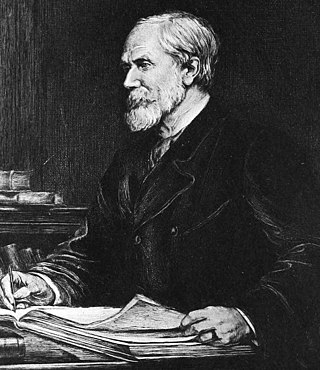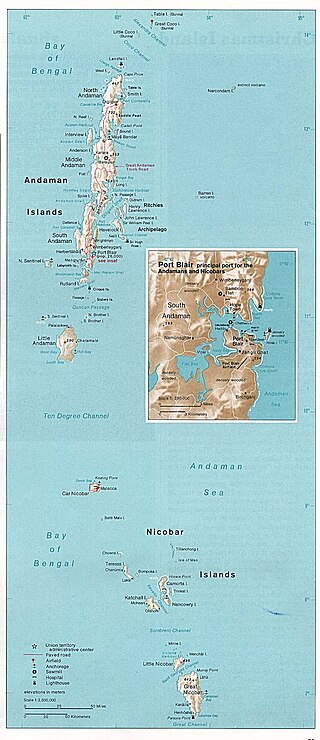Related Research Articles

Colonel Sir Henry Yule was a Scottish Orientalist and geographer. He published many travel books, including translations of the work of Marco Polo and Mirabilia by the 14th-century Dominican Friar Jordanus. He was also the compiler of a dictionary of Anglo-Indian terms, the Hobson-Jobson, with Arthur Coke Burnell.

A jungle is land covered with dense forest and tangled vegetation, usually in tropical climates. Application of the term has varied greatly during the past recent century.

Kedgeree is a dish consisting of cooked, flaked fish, boiled rice, parsley, hard-boiled eggs, curry powder, lemon juice, sea salt, butter or cream, and occasionally sultanas.

A mandarin was a bureaucrat scholar in the history of China, Korea and Vietnam.
The Hornby Vellard was a project to build a causeway uniting all seven islands of Bombay into a single island with a deep natural harbour. The project was started by the governor William Hornby in 1782 and all islands were linked by 1838. The word vellard appears to be a local corruption of the Portuguese word vallado meaning fence or embankment. The seven islets – their anglicised names being Colaba, Old Woman’s Island, Bombay, Mazgaon, Parel, Mahim and Worli – came to the British in 1661 as part of the dowry of Charles II, who married into the Portuguese royal family. Bombay was quickly palmed off to the East India Company for a paltry £10 a year and later the company identified that more land means more money hence got interested in the project.

The lesser bandicoot rat, Sindhi rice rat, Bengal rat or Indian mole-rat is a giant rat of Southern Asia, not related to the true bandicoots which are marsupials. They can be up to 40 cm long, are considered a pest in the cereal crops and gardens of India and Sri Lanka, and emit piglike grunts when attacking. The name bandicoot is derived from the Telugu language word pandikokku, which translates loosely to "pig-rat". Like the better known rats in the genus Rattus, bandicoot rats are members of the family Muridae. Their fur is dark or (rarely) pale brown dorsally, occasionally blackish, and light to dark grey ventrally. The head-body length is around 250 mm, and the uniformly dark tail is shorter than the head-body length.

Arthur Coke Burnell was an English civil servant who served in the Madras Presidency who was also a scholar in Sanskrit and Dravidian languages. He catalogued the Sanskrit manuscripts in southern India, particularly those in the collections of the Tanjore court collections. He was, with Henry Yule, a co-compiler of the Hobson-Jobson, a compendium of Anglo-Indian terms.
Yā Muhammad or "Yā Rasūl Allāh" are Arabic expressions referring to the Islamic prophet Muhammad.
Churidars, also churidar pyjamas, are tightly fitting trousers worn by both men and women in the Indian subcontinent. Churidars are a variant of the common shalwar pants. Shalwars are cut wide at the top and narrow at the ankle. Churidars narrow more quickly so that contours of the legs are revealed. They are usually cut on the bias, making them naturally stretchy, which is important when pants are closefitting. They are also longer than the leg and sometimes finish with a tightly fitting buttoned cuff at the ankle. The excess length falls into folds and appears like a set of bangles resting on the ankle. When the wearer is sitting, the extra material is the "ease" that makes it possible to bend the legs and sit comfortably. The word churidar is from Hindi and made its way into English only in the 20th century. Earlier, tight-fitting churidar-like pants worn in India were referred to by the British as Moghul breeches, long-drawers, or mosquito drawers.
Yā Hussain is an Arabic phrase used by Shia Muslims to invoke the memory or intervention of Hussain ibn Ali. It is especially used in the context of the Mourning of Muharram.

The green avadavat or green munia is a species of Estrildid finch with green and yellow on the body, a bright red bill and black "zebra stripes" on the flanks. They are endemic to the Indian subcontinent and were formerly popular as cagebirds. The name "avadavat" is a corruption of the name the city of Ahmedabad in Gujarat, India, which was a centre of bird trade. They have a restricted distribution and populations are threatened by the bird trade.
The kos, also spelled coss, koss, kosh, krosh, and krosha, is a unit of measurement which is derived from a Sanskrit term, क्रोश krośa, which means a 'call', as the unit was supposed to represent the distance at which another human could be heard. It is an ancient Indian subcontinental standard unit of distance, in use since at least 4 BCE. According to the Arthashastra, a krośa or kos is about 3,000 metres (9,800 ft).
Butler English, also known as Bearer English or Kitchen English, is a dialect of English that first developed as an occupational dialect in the years of the Madras Presidency in India, but that has developed over time and is now associated mainly with social class rather than occupation. It is still spoken in major metropolitan cities.
A sheristadar was once the chief administrative officer in Indian courts entrusted with the tasking of receiving and checking court pleas. The word is derived from the Persian word sarishta-dār meaning "Administrative Officer of the court". They were responsible for the entire district judicial administration through the Principal District & Sessions Court, supervising all activities including record keeping
Swamy Jewellery is a type of gold and silver jewellery manufactured in the city of Tiruchirappalli in Tamil Nadu, India. Tamil Nadu has a 5000-year-old history of jewellery-making, using materials ranging from fine silver and gold to modern eco-friendly materials such as terra-cotta and jute.

A grab was a type of ship common on the Malabar Coast in the 18th and 19th centuries. The name derives from "ghurāb" or "ghorāb", Arabic for raven, which in turn came into Marathi and Konkani as "gurab". The ghurāb was originally a galley, but the type evolved.

The gallivat was a small, armed boat, with sails and oars, used on the Malabar Coast in the 18th and 19th centuries. The word may derive from Portuguese "galeota" or alternatively, from the Maratha "gal hat" ship. Hobson-Jobson has an extensive discussion of the origins of the term and its usage.

The Andaman Tamils are Tamil-speaking people of the Andaman and Nicobar Islands, commonly known as the Madrasi. There are three groups. The first are those who migrated from Tamil Nadu in search of livelihood and are found in almost all the islands where human beings are settled. The second are Tamil-speaking repatriates from Myanmar who migrated after the military junta came to power in the then Burma. The third group are Tamil-speaking repatriates from Sri Lanka who migrated after ethnic clashes began there. The population of the first group is largest and is still swelling as the migration continues.
Sullimany, was built at Demaun between 1795 and 1799, registered in Bombay after 1803, and was still sailing c.1840. She was originally a country ship. A French privateer captured her in 1799, but an East Indiaman fortuitously recaptured her shortly thereafter. She also served as a transport in two British military campaigns.
Dorea was a type of striped or check patterned cloth made in the Indian subcontinent. The continued striped Dorea was a simplest form of Dorea.
References
- Yule, Henry; Burnell, A.C. (1903). Hobson-Jobson: A glossary of colloquial Anglo-Indian words and phrases, and of kindred terms, etymological, historical, geographical and discursive. William Crooke ed. London: J. Murray. (Searchable database)
- Mishra, Vijay (2009). "Rushdie-Wushdie: Salman Rushdie's Hobson-Jobson". New Literary History. 40 (2): 385–410. doi:10.1353/nlh.0.0087. JSTOR 27760263. S2CID 162138441.
- Nagle, Traci (2010). "'There is much, very much, in the name of a book' or, the Famous Title of Hobson-Jobson and How it Got That Way", in Michael Adams, ed., 'Cunning passages, contrived corridors': Unexpected Essays in the History of Lexicography, pp. 111–127.
- ———— (2014). "The Visible and Invisible Influence of Yule's Hobson-Jobson on Murray's Oxford English Dictionary". International Journal of Lexicography. 27 (3): 280–308. doi:10.1093/ijl/ecu013.
- Pelliot, Paul (1903). "(Review)". Bulletin de l'École française d'Extrême-Orient. 3 (3): 477–479. JSTOR 43729736.
- Purcell, Susan (2009). "The Law of Hobson-Jobson". English Today. 25 (1): 60–64. doi:10.1017/S0266078409000108. S2CID 145468193 . Retrieved 2011-05-12.
- Rushdie, Salman, "Hobson-Jobson", in Imaginary Homelands: Essays & Criticisms, 1981–1991, also collected in Travelers' Tales India by James O'Reilly and Larry Habegger, pp. 97–100.
- Shapiro, Michael C. (1989). "(Review)". Journal of the American Oriental Society. 109 (3): 474. doi:10.2307/604171. hdl: 2027/hvd.32044010693141 . JSTOR 604171.
- Teltscher, Kate (2017). "Hobson‐Jobson: The East India Company Lexicon". World Englishes. 36 (4): 509–521. doi:10.1111/weng.12285.